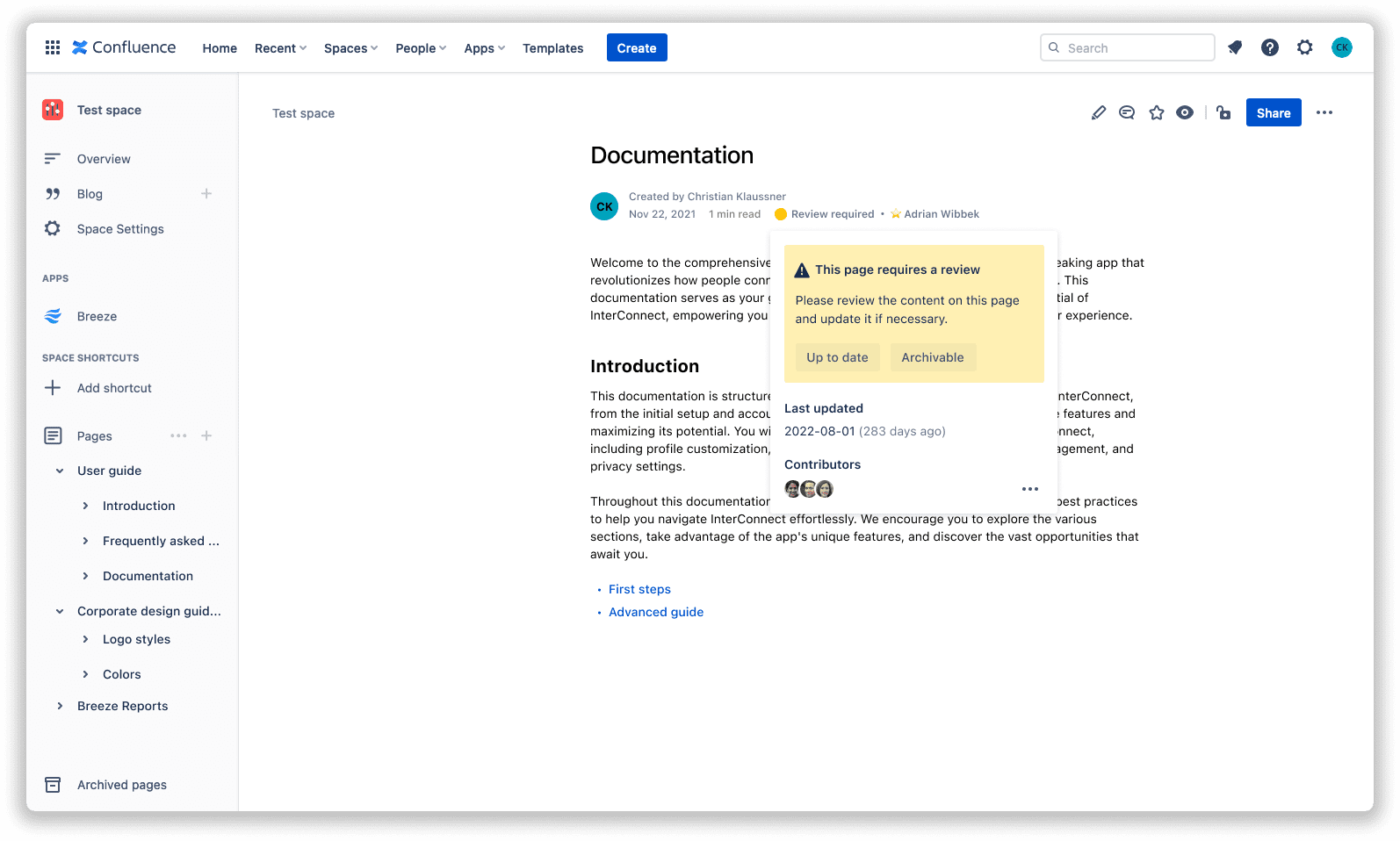Have you ever come across one of the following scenarios using Confluence?
- You visit a page and wonder: Is it up to date?
- You find an outdated page but don't know who's responsible for it, i.e., who is the page owner?
- You can't find what you're looking for because it's gotten lost in the flood of pages.
Whether you're part of a small or large company, the thing with Confluence is that once you start creating vast volumes of content, you will inevitably need someone to help with lifecycle management, which is where Breeze by B1NARY comes in.
Breeze is a content management app for Confluence that helps with all of the above challenges. It automates the identification of outdated content and ensures your Confluence is free of clutter.
What is content lifecycle management?
Content management is the process of collecting, delivering, retrieving, governing, and managing information in any format. The term is typically used to refer to the administration of the digital content lifecycle, from creation to permanent storage or deletion.
Before we start let's take a quick look at the content management lifecycle to fully understand where Breeze comes into play.
Breeze's part in the content management lifecycle
In theory, there are up to seven stages through which a page or a document passes (depending on requirements):
- Planning
- Creating
- Storing and organizing
- Editing and approving
- Publishing and distributing
- Reporting
- Preserving (removing, archiving, updating)
Breeze focuses on reporting and preserving, offering three key functions:
Automated identification of outdated content: Breeze analyzes the Confluence instance at regular intervals and automatically identifies outdated content.
Customized workflows and rules: With Breeze, customized workflows and rules can be defined to adapt the content lifecycle precisely to your company's needs. From reporting to archiving, full control is maintained.
Notifications and reporting: The app automatically generates reports and notifies those responsible about the status of pages. This means that decision-makers always have an overview and can take action when necessary.
The report gives content owners, page creators, and collaborators an overview of the various Confluence pages. The automation tags pages as "up to date," "in need of a review," or "could possibly be archived." Because each space has its own needs, the settings behind the functionality can be assigned on an individual basis.
How does Breeze work?
To show Breeze in action, we created a demo workflow. We set 90 days without an update as a condition for marking a page as "review required" and defined the page owner and last contributor of the identified pages to be notified of the pending review.
Pages not updated for a year were marked as "archivable." For all these pages, Breeze notifies the respective page owner as well as the user "Martin," who in our example could be the only user with archiving rights and should therefore be informed about every page to be archived.

Afterward, we assigned the workflow to a space, and on executing the workflow, the space looked like this:

In addition to this page overview of a space, Breeze generated an analysis report after each workflow execution. This report includes various metrics, such as the distribution of pages based on their status and the resulting quality score of the space. Below, the pages to be reviewed are listed, along with the individuals responsible for them.
Breeze utilizes Confluence's mention feature, where an "@" is prefixed to a username, notifying them via email or Slack, depending on the preference.
Importantly, Breeze does not send user data externally and provides a high level of data privacy by leveraging Confluence's built-in notification system!

In addition to the reports, Breeze provides features to assist responsible individuals in regularly reviewing and keeping pages up to date. For example, at the top of each page, you can see the latest status, indicating whether it is current or needs an update.

Conveniently, after reviewing the content, the page can be directly reset to the "up to date" status. Alternatively, if the review indicates that the page is no longer needed, it can be marked as "archivable."

To make the review of pages even easier, Breeze provides overviews of all pages to be reviewed or archived within a space. Using a filter, all pages to be reviewed, falling under the responsibility of a specific person, are displayed.

The view of archivable pages also displays comments, allowing individuals responsible for archiving pages to better understand why they are no longer needed. With just a few clicks, these pages can be archived collectively (bulk archiving) or deleted (bulk deletion).
Interestingly, bulk archiving of pages is typically only available within Confluence Premium. However, Breeze provides this feature for Confluence Standard.

To understand the impact of maintenance measures over time, Breeze provides a dedicated analytics component that graphically represents the quality of a space.

Additionally, there is a global overview of all spaces, where all key metrics can be captured at a glance. This allows spaces that require a bit more attention to be quickly identified and actioned.

Published: Jan 12, 2024
Updated: Nov 18, 2024


